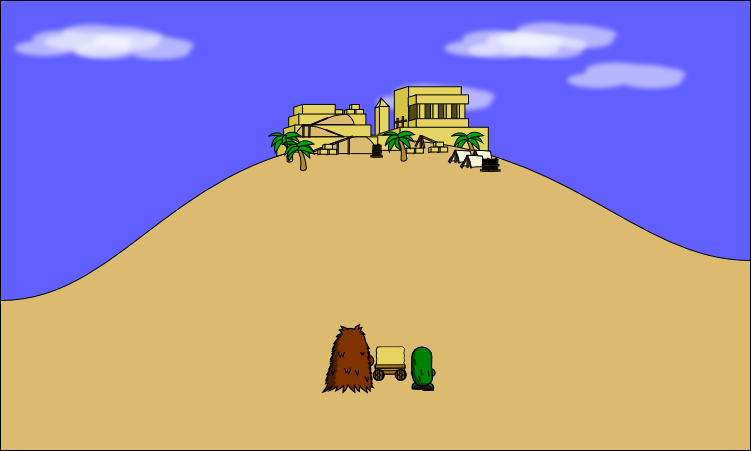Lesson 2
 The Ramp or Inclined Plane
The Ramp or Inclined Plane
When we were last with the members of our Aspire crew, Pic and Harry used two simple machines, the wedge to help shape stones, and the lever to help lift these stones onto a cart for transport to the building site. They are now faced with moving these massive stones up the hill to the location of the building.
They have agreed the only way they can accomplish this task is by creating an inclined plane. The stones they are working with weigh 3480 N (that's close to 800 pounds) and have to be pulled 100 meters (a little more than the length of a football field) up a steep hill. They are not strong enough to push the massive stones up this hill (incline) and the stones would be of no use if they were broken into smaller sizes. Let's investigate the advantages of using an inclined plane.

If you looked at the hill in cross section you could see that it is already an inclined plane but it is too steep for us to move our stones.
Data Collection::
Table 1:
the Inclined Plane
You can adjust the length of the inclined plane by clicking and dragging on the gray slider. By doing this we can select a better incline for what we need to do.
When you adjust the length of the inclined plane and click (push), the length of the ramp and the effort force needed to move the stone will be displayed. (In our figures, we will disregard the effects of friction) Copy this information onto Table 1 in your lab packet.
Repeat this for 5 or more lengths.
Analysis Questions :
- From your chart of data, find the maximum effort our crew member can sustain to push the stone up the inclined plane.
- What is the length of this inclined plane?
- Would this be the ideal length to use for the inclined plane?
- What other factors might you consider?

Talk Now - 2b
Discuss this with your partner, use complete sentences to defend your choice for the ideal length.
Data Analysis - 1: calculate work done with inclined plane
Copy your data from Table 1 onto Table 2 in your lab packet.
Calculate the amount of work done to get the stone to the top of each inclined plane.
Remember!
Work = Force Applied X Distance mass is moved
If the stone had been lifted straight up 40 m, the work done would have been 3480 N X 40 m. This would equal 139,200 Nm or 139,200 joules.
How do the values of work found for the various lengths of inclined plane compare to this value? Write your answer in your lab packet using complete sentences.



